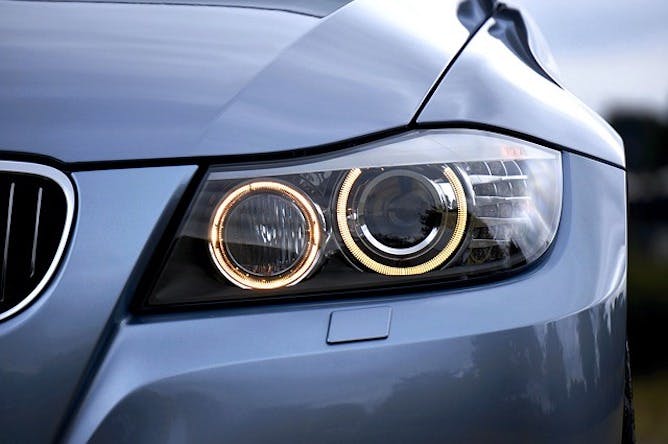
We’ve come a fair way since candle-lit, horse-drawn carriages, but one thing hasn’t changed: we still need extra light to help us travel safely at night and in poor weather conditions. These days, cars are equipped with not one, but two different types of headlights—a welcome advance, but one that means there are more decisions to make. So, how do you work out whether to keep your headlights dipped, or if it’s time to go full beam ahead?
We’ll explain the rules you have to follow in order to get the best visibility, help you fully assess hazards on the road, and let others see exactly where you are. By the end of this guide, you’ll know how to use your headlights as a safe and considerate driver—and be ready to hit the roads, even after dark.
What is the difference between dipped headlights and full beam?
If you're fairly new to driving at night, you may not have heard of dipped headlights before. But even if you’re unfamiliar with the term, you probably have more idea about them than you think. In fact, dipped headlights is just another way of saying "headlights". The reason they are sometimes referred to as dipped, or low-beam, is because they are angled downwards—giving you enough light to travel by when visibility is poor, without dazzling other drivers.
Not only do your headlights help you see ahead, but they are also connected to your tail lights, so that you're visible to other road users travelling behind.
In certain situations, where you need a greater field of vision, you may benefit from putting on your full—or main—beam headlights. These are located within the same headlight unit as your normal headlights, but are much brighter. Full beams are also angled higher: you can see further and wider than is possible when they’re dipped, helping you to anticipate hazards sooner. However, they are too strong to use when there are other vehicles travelling in front of you in the same direction, or approaching you on the opposite side of the road.
To avoid dazzling drivers behind you, full beams are limited to the front of your car; your tail lights will remain on, but won't brighten, when you opt for full beam headlights.
When should I use dipped headlights?

With 3 main levels of lighting available to you—sidelights, dipped headlights and full beams—you’ll often have to decide which option is most appropriate for your current situation.
Thankfully, the Highway Code provides some guidance. Rule 113 says that you should stick your headlights on:
- during hours of darkness (half an hour after sunset to half an hour before sunrise), or
- when faced with poor weather during the day
Sometimes it’s easy to establish the need for headlights. In the pouring rain, for instance, where spray from the road is seriously compromising your visibility, or in the pitch black, where you can’t see at all, then there’s no question that you should switch them on.
Even so, there are plenty of times where it’s entirely legal to drive with your sidelights on instead of your headlights—when it’s just a bit dull, for example. You’re technically even allowed to drive on sidelights at night, so long as you’re in a well-lit, built up area with a speed limit of 30mph or lower. In these situations, you’ll have to use your judgement. If in doubt, opt for headlights over sidelights, as they’ll help you see much more of the road ahead, and your vehicle will be more visible to other road users.
Do Daytime Running Lights count as headlights?
If you're driving a newer vehicle, it'll probably be equipped with Daylight Running Lights (DRLs). These are lights that automatically come on whenever you start the engine. However, they are not a substitute for headlights, or even sidelights, because they don't connect to your rear lights. Other vehicles will therefore struggle to see you—so never let them affect your decision to turn on your dipped beam.
When should I use my full beam headlights?

Main beams are an incredibly useful feature for night driving, but can be dangerous when used incorrectly. There are 2 key questions you should ask yourself before switching them on.
How they will they affect others on the road?
According to Rule 114 of the Highway Code, you:
“must not use any lights in a way which would dazzle or cause discomfort to other road users, including pedestrians, cyclists and horse riders”.
In other words, full beams are out of the question when there are others driving in the opposite direction, towards you. They are also a big no-no if you’re following someone and are within about 300m of them. Any closer, and your main beams will bounce off their mirrors, and cause problems for their vision.
How they will affect you?
You only want to use your full beams when they’re actually going to be helpful. Your dipped headlights are adequate for most of the time. But when it’s dark and the road is unlit, your vision can often do with a bit of a boost. Full beams can be particularly useful on country roads, where you may be unfamiliar with the road layout, and are struggling to contemplate corners and bends in advance.
When should I dip my full beams?
With that is mind, there are some instances where main beams are simply not appropriate, or you may need to quickly switch between different lights on your car.
Corners and hills
As you approach corners or the summit of hills, you should dip your headlights (turn them from full beam to dipped beam). If you wait until you’re on the bend, then anyone approaching is likely to get dazzled. As soon as you’ve passed the vehicle, it’s safe to turn your full beam headlights on again in order to see the road more clearly.
Overtaking
When you’re overtaking a vehicle at night, keep your headlights dipped until you are level with the vehicle you’re passing.
If you’re the driver being overtaken, you should dip your headlights as soon as any other vehicle draws level with you. Otherwise, you risk dazzling them through their mirrors. When they’re in front of you, you should have an easier time tracking the road anyway, simply by watching their tail lights.
In fog
It makes sense that main headlights can blind other road users—but did you know that they can sometimes dazzle you, too? Visibility is often at its worst when you drive in fog, so you might be tempted to stick on your full beams to try and see just that little bit further. However, that’s just about the worst thing you could do.
Because of the way your full beams are angled, what really happens in this situation is that the light bounces off the fog and back into your eyes. Not ideal when you’re already struggling to see! Instead, combine your dipped headlights and fog lights for the greatest effect—and drive slowly to compensate for your restricted visibility.
Remember to turn your fog lights off as soon as you’re in the clear though, as these, too, can dazzle other drivers.
Other uses for full beams
Drivers sometimes flash their main beams as a way of communicating with other road users. The Highway Code allows this, so long as you are only doing so to let others know that you’re there. It warns against "assum[ing] that flashing headlights is a signal inviting you to proceed"—like when you're waiting to pass parked cars—particularly in light of ‘flash-for-cash’ schemes.
If someone does flash their lights at you during the night, though, just double check that you haven't left your own main beams on by accident.
What should I do if someone dazzles me with their headlights?
Occasionally, another driver might forget to dip their headlights—or be slow at doing so—as they follow or approach you. You could find yourself blinded with brightness, which is scary even for experienced drivers.
If you are dazzled by another driver’s lights, then slow down. If you’re really struggling to see—and it’s safe to do so—stop and wait until the danger has passed.
Where the offending driver is behind you, you might be able to reduce the glare. Some cars are now fitted with auto-dimming rear view mirrors. Otherwise, manually switching your mirror to ‘night mode’ can help to reduce the shine into your eyes.
Headlights and Full Beams: FAQs
How do you turn on your dipped headlights?
On most cars, you can turn on your headlights using the indicator stalks or by turning a dial on your dashboard. To change to full beams, you’ll usually find that you can push the indicator stalk outwards, and it will click into place. Make sure you know how to turn all of your car lights on and off before starting a journey.
How will using dipped headlights help on a well-lit road?
Even if you have good visibility when travelling along a well-lit road at night, turning your dipped beams on will help other road users see you better. It’s safer for everyone when you use your headlights, rather than just your sidelights, during hours of darkness.
Can I get pulled over for having a headlight out?
Yes, the police can pull you over if one of your headlights has stopped working. They may even issue you with a fine, because it’s dangerous to drive without full visibility. To avoid this, make sure you regularly check that all your lights are both clean and working.
Can I use fog lights as headlights?
Never use your fog lights as an alternative to your headlights, as they will dazzle other road users. You should only turn your fog lights on when your visibility is seriously reduced (less than 100m).
Can I drive with brights on if my headlight is out?
No, you should never use your full-beam headlights as a replacement for your dipped beams, even if one of your bulbs has blown. You’ll end up dazzling other drivers, which can easily lead to accidents. If one of your headlights is out, get it replaced as soon as possible.
Keep safe on the roads with our other driving tips: check out our guide to navigating box junctions, make sure you know when to stick your hazards on, and learn how to tell what the national speed limit is on any road in the UK.
Subscribe for driving advice, offers & more
We'd love to let you know about our courses, news and offers via email. You may unsubscribe at any time.
Star Genie Limited trading as PassMeFast. Company number 10093359
Copyright © 2024 owned by Star Genie Limited
PassMeFast, Blue Tower, MediaCityUK, Salford, M50 2ST
